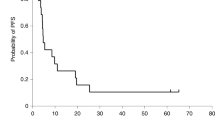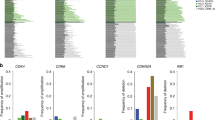Abstract
Contradictory experimental results and human trials have questioned the clinical relevance of the HSVtk/ganciclovir system. To bypass the problem of transfection efficiency, we used a glioma cell line stably expressing the HSVtk gene, which was also fully characterized from gene to protein. We also designed a more clinically relevant experimental protocol, consisting of late GCV delivery on large tumor formations. In short-term studies, histological examination revealed a significant decrease in tumor volume in GCV-treated animals from day 1 or from day 10 after cell inoculation. We observed that late GCV delivery is as efficient as early delivery, probably because GCV can reach tumor cells more easily when neoangiogenesis occurs. In long-term experiments, the survival of treated rats bearing 15-day tumors was improved by 60% compared with C6 control animals. Surprisingly, a 30% survival rate was observed in C6TK control animals. Nuclear magnetic resonance imaging demonstrated, in all surviving animals, a complete regression of tumors without mass effect. These results clearly demonstrate that the HSVtk/GCV system remains a potent therapeutic strategy, even when tested in large tumors, in contrast with the microscopic tumor formations previously reported.
This is a preview of subscription content, access via your institution
Access options
Subscribe to this journal
Receive 12 print issues and online access
$259.00 per year
only $21.58 per issue
Buy this article
- Purchase on Springer Link
- Instant access to full article PDF
Prices may be subject to local taxes which are calculated during checkout








Similar content being viewed by others
References
Ahsan H, Neugut AI, Bruce JN . Trends in incidence of primary malignant brain tumors in USA, 1981–1990 Int J Epidemiol 1995 24: 1078–1085
Walker MD et al. Randomized comparisons of radiotherapy and nitrosoureas for the treatment of malignant glioma after surgery New Eng J Med 1980 303: 1323–1329
Mahaley MS Jr et al. National survey of patterns of care for brain-tumor patients JNeurosurg 1989 71: 826–836
Kim TS, Hallidary AL, Hedley-Whyte ET, Convey K . Correlates of survival and the Daumans–Duport grading system for astrocytoma J Neurosurg 1991 74: 27–37
Black PM . Brain tumors New Engl J Med 1991 324: 1555–1564
Culver KW et al. In vivo gene transfer with retroviral vector-producer cells for treatment of experimental brain tumors Science 1992 256: 1550–1552
Kornblith PK, Welch WC, Bradley MK . The future of therapy for glioblastoma Surg Neurol 1993 39: 538–543
Mizuno M, Yoshida J . Gene therapy for brain tumors Nippon Rinsho 1997 55: 1853–1860
Hoang-Xuan K, Li YJ, Hamelin R, Delattre O . Molecular biology in cerebral gliomas: recent advances Rev Neurol (Paris) 1995 151: 608–618
Scheck AC et al. Biological and molecular analysis of a low-grade recurrence of a glioblastoma multiforme Clin Cancer Res 1996 2: 187–199
Ezzedine ZD et al. Selective killing of glioma cells in culture and in vivo by retrovirus transfer of the herpes simplex virus thymidine kinase gene New Biol 1991 3: 608–614
Chen SH et al. Gene therapy for brain tumors: regression of experimental gliomas with adenovirus-mediated gene transfer in vivo Proc Natl Acad Sci USA 1994 91: 3054–3057
Elion GB . Mechanism of action and selectivity of acyclovir Am J Med 1982 73: 7–13
Moolten FL . Tumor chemosensitivity conferred by inserted herpes thymidine kinase genes: paradigm for a prospective cancer control strategy Cancer Res 1986 46: 5276–5281
Plautz G, Nabel EG, Nabel GJ . Selective elimination of recombinant genes in vivo with a suicide retroviral vector New Biol 1991 3: 709–715
Moolten FL . Drug sensitivity (‘suicide’) genes for selective cancer chemotherapy Cancer Gene Ther 1994 1: 279–287
Barba D, Hardin J, Ray J, Gage F . Thymidine kinase-mediated killing of rat brain tumors J Neurosurg 1993 79: 729–735
Izquierdo M et al. Long-term rat survival after malignant brain tumor regression by retroviral gene therapy Gene Therapy 1995 2: 66–69
Maron A et al. Gene therapy of rat C6 glioma using adenovirus-mediated transfer of the herpes simplex virus thymidine kinase gene: long-term follow-up by magnetic resonance imaging Gene Therapy 1996 3: 315–322
Zhu J et al. A continuous intracerebral gene delivery system for in vivo liposome-mediated gene therapy Gene Therapy 1996 3: 472–476
Sugaya S et al. Inhibition of tumor growth by direct intratumoral gene transfer of herpes simplex virus thymidine kinase gene with DNA–liposome complexes Hum Gene Ther 1996 7: 223–230
Tamura M et al. Targeted killing of migrating glioma cells by injection of HTK-modified glioma cells Hum Gene Ther 1997 8: 381–391
Caruso M et al. Regression of established macroscopic liver metastases after in situ transduction of a suicide gene Proc Natl Acad Sci USA 1993 90: 7024–7028
Moolten FL, Wells JM, Heyman RA, Evans RM . Lymphoma regression induced by ganciclovir in mice bearing a herpes thymidine kinase transgene Hum Gene Ther 1990 1: 125–134
Osaki T et al. Gene therapy for carcinoembryonic antigen-producing human lung cancer cells by cell type-specific expression of herpes simplex virus thymidine kinase gene Cancer Res 1994 54: 5258–5261
Vile GR, Hart IR . Use of tissue specific expression of the herpes simplex virus thymidine kinase gene to inhibit growth of established murine melanomas following direct intratumoral injection of DNA Cancer Res 1993 53: 3860–3864
Bonnekoh B et al. Inhibition of melanoma growth by adenoviral-mediated HSV thymidine kinase gene transfer in vivo J Invest Dermatol 1995 104: 313–317
Golumbek PT et al. Herpes simplex-1 virus thymidine kinase gene is unable to completely eliminate live, nonimmunogenic tumor cell vaccines J Immunother 1992 12: 224–230
Takamiya Y et al. An experimental model of retrovirus gene therapy for malignant brain tumors J Neurosurg 1993 79: 104–110
Cool V et al. Curative potential of herpes simplex virus thymidine kinase gene transfer in rats with 9L gliosarcoma Hum Gene Ther 1996 7: 627–635
Ram Z et al. Therapy of malignant brain tumors by intratumoral implantation of retroviral vector-producing cells Nature Med 1997 3: 1354–1361
Deliganis AV et al. Serial MR in gene therapy for recurrent glioblastoma: initial experience and work in progress Am J Neuroradiol 1997 18: 1401–1406
Chen CY et al. Effect of herpes simplex virus thymidine kinase expression levels on ganciclovir-mediated cytotoxicity and the ‘bystander effect’ Hum Gene Ther 1995 6: 1467–1476
Iwadate Y et al. In vivo bystander effect in the intracranial model with rat glioma cells reflects the clonal difference of HSV-TK positive cells Int J Oncol 1996 9: 521–525
Beck C et al. The thymidine kinase/ganciclovir-mediated ‘suicide’ effect is variable in different tumor cells Hum Gene Ther 1995 6: 1525–1530
Sturtz FG et al. Variable efficiency of the thymidine kinase/ganciclovir system in human glioblastoma cell lines: implications for gene therapy Hum Gene Ther 1997 8: 1945–1953
Tapscott SJ et al. Gene therapy of rat 9L gliosarcoma tumors by transduction with selectable genes does not require drug selection Proc Natl Acad Sci USA 1994 91: 8185–8189
Benedetti S et al. Limited Efficacy of the HSV-TK/GCV system for gene therapy of malignant gliomas and perspectives for the combined transduction of the interleukin-4 gene Hum Gene Ther 1997 8: 1345–1353
Barth RF . Rat brain tumor models in experimental neuro-oncology: the 9L, C6, T9, F98, RG2 (D74), RT-2 and CNS-1 gliomas J Neurooncol 1998 36: 91–102
Benabid AL, Remy C, Chauvin C . Experimental models of rat brain tumors by stereotaxic injection of C6 glioma and HTC hepatoma cell lines. In: Walker and Thomas (eds) . Biology of Brain Tumor Martinus Nijhoff: Boston 1986 221–226
Ram Z et al. The effect of thymidine kinase transduction and ganciclovir therapy on tumor vaculature and growth of 9L gliomas in rats J Neurosurg 1994 81: 256–260
LeMay DR et al. Intravenous RMP-7 increases delivery of ganciclovir into rat brain tumors and enhances the effects of herpes simplex virus thymidine kinase gene therapy Hum Gene Ther 1998 9: 989–995
Plate KH, Risau H . Angiogenesis in malignant gliomas Glia 1995 15: 339–347
Abina MA et al. Lac Z gene transfer into tumor cells abrogates tumorigenicity and protects mice against the development of further tumors Gene Therapy 1996 3: 212–216
Moolten FL, Wells JM, Mroz PJ . Multiple transduction as a means of preserving ganciclovir chemosensitivity in sarcoma cells carrying retrovirally transduced herpes thymidine kinase genes Cancer Lett 1992 64: 257–263
Hamel W, Magnelli L, Chiarugi VP, Israel MA . Herpes simplex virus thymidine kinase/ganciclovir-mediated apoptotic death of bystander cells Cancer Res 1996 56: 2697–2702
Freeman SM et al. The ‘bystander effect’: tumor regression when a fraction of the tumor mass is genetically modified Cancer Res 1993 53: 5274–5283
Thomas KR, Capecchi MR . Site-directed mutagenesis by gene targeting in mouse embryo-derived stem cells Cell 1987 51: 503–512.
Apt KE, Kroth-Pancic PG, Grossman AR . Stable nuclear transformation of the diatom Phaeodactylum tricornutum Mol Gen Genet 1996 252: 572–579
Kobayashi NN, Allen N, Clendenon NR, Li-Wen KO . An improved rat brain tumor model J Neurosurg 1980 53: 808–815
Fyfe JA et al. Thymidine kinase from herpes simplex virusphosphorylates the new antiviral compound, 9-(2-hydroxyethoxymethy) guanine J Biol Chem 1978 253: 8721–8727
Montero-Menei CN et al. Liposaccharide intracerebral administration induces minimal inflammatory reaction in rat brain Brain Res 1994 653: 101–111
Kaplan EL, Meier P . Nonparametric estimation from incomplete observations J Am Stat 1958 53: 457–481.
Acknowledgements
We would like to thank Dr J Janicot (Rhone-Poulenc Rorer Gencell) for the polyclonal rabbit-anti-HSV/TK serum and Dr R Barnoud for the Factor VIII immunological study. This work was supported by grants from the Centre d’application et Réseau de Thérapie Génique (Ministère de la Santé, Fondation pour la Recherche Médicale, Association Française de lutte contre les Myopathies, Ligue Contre le Cancer), ARC and Espoir.
Author information
Authors and Affiliations
Rights and permissions
About this article
Cite this article
Bouali-Benazzouz, R., Lainé, M., Vicat, J. et al. Therapeutic efficacy of the thymidine kinase/ganciclovir system on large experimental gliomas: a nuclear magnetic resonance imaging study. Gene Ther 6, 1030–1037 (1999). https://doi.org/10.1038/sj.gt.3300921
Received:
Accepted:
Published:
Issue Date:
DOI: https://doi.org/10.1038/sj.gt.3300921



